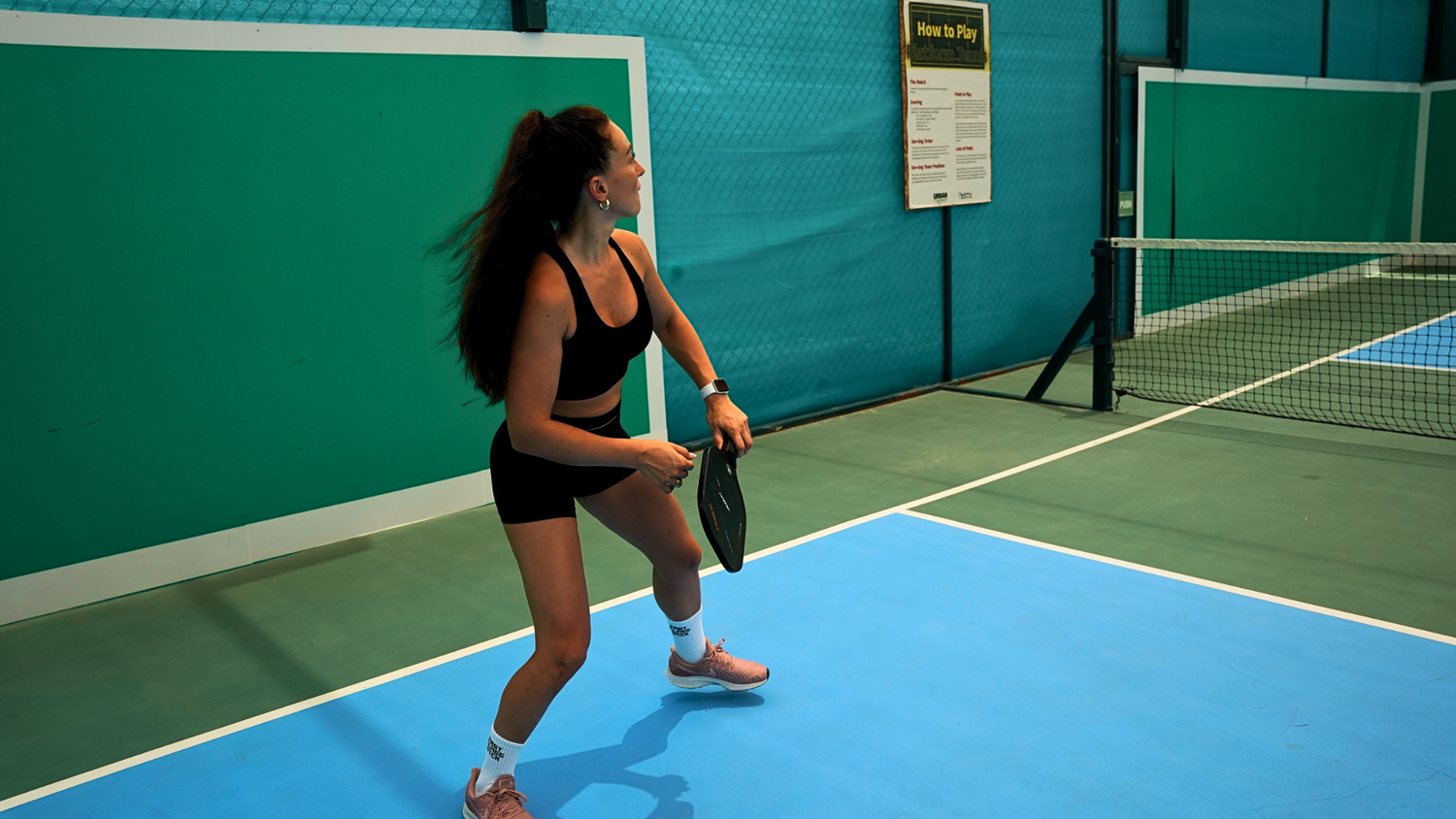Introduction
Pickleball is a thrilling sport that combines elements of tennis, badminton, and table tennis. While it is commonly played in doubles, singles pickleball offers a unique challenge that is both exhilarating and fun to showcase your skills and strategies on the court.
In this comprehensive guide, we will explore the rules and regulations of singles pickleball, and then delve into more advanced strategies to help you dominate the game.
Before we dive into the strategies, it's essential to have a deep understanding of the rules that govern singles pickleball:
Court Setup
The singles pickleball court is the same size as a doubles court, measuring 20 feet wide and 44 feet long. The court is divided into two equal halves by a net that stands 36 inches high at the sidelines and 34 inches high at the centre. Each half of the court features a non-volley zone, often referred to as "the kitchen," which extends 7 feet from the net.

Knowing positioning and movement in and around the court can make the difference between a win or a loss. And in pickleball, it’s also essential to be mindful of “The Kitchen” or commonly referred to as the non-volley zone. More on this later.
The Serve
The serve is a critical part of singles pickleball, and specific rules apply when it comes to serving, like:
- All serves in pickleball must be served underhand. No overhead serves like Tennis.
- The server's arm must be moving in an upward arc when the ball is struck.
- Paddle contact with the ball must not be made above the waist level.
- Alternatively, a 'drop serve' is allowed, in which case none of the previously mentioned restrictions apply.
- At the moment of striking the ball, a server’s feet must be outside of court lines.
Serving Sequence
Understanding the serving sequence is essential to navigating singles pickleball effectively:
- The first serve is executed from the right/even court with a starting score of 0-0.
- After scoring a point, the server switches sides, initiating the next serve from the left/odd court.
- This pattern continues, with the server switching sides after each point is won, until a fault occurs.
- When the server loses their serve, a “sideout” occurs and the opponent gets a chance to serve.
- When a player gets to serve again, depending on your points, you will either start from the right (even points) or left (odd points).
Scoring
Scoring in singles pickleball is as follows:
- Only the serving team can score points. You need to first earn the chance to serve before scoring points.
- Games are typically played to 11 points, with the requirement of winning by at least 2 points if the game is tied.
- In tournament play, games may extend to 15 or 21 points, following the same winning margin rule.
Two-Bounce Rule
The two-bounce rule adds complexity and strategy to the game and is essential to keep the game fair and competitive. It works like this:
- When the ball is served, both the serving and receiving teams must allow it to bounce once on each side before a volley can occur.
- After it bounces once on each side, both players can either volley the ball (hit it before it bounces) or play it as a groundstroke (let it bounce once).
This rule encourages longer rallies by eliminating the positional advantage of the receiving team and testing players' groundstroke abilities.
Line Calls
Understanding how line calls work is crucial for fair play:
- If any part of the ball contacts any part of any line, except the non-volley zone line during a serve, it is considered "in."
- A serve contacting the non-volley zone line is short and constitutes a fault.
Non-Volley Zone (the Kitchen)
The non-volley zone, commonly referred to as "the kitchen," is a critical area with specific rules:
- Volleying the ball within this zone is prohibited. This rule prevents players from executing smashes from within the zone.
- It is considered a fault if, while volleying the ball, a player steps on the non-volley zone, including the lines, or if the player's momentum causes them or anything they are wearing or carrying to touch the non-volley zone, including the lines outlining the Kitchen.
- Even after volleying, a player may legally be in the non-volley zone at any time other than when volleying the ball.
- You’re also allowed to be in the Kitchen when taking a groundstroke – as long as the ball has bounced in the Kitchen.
Faults
Understanding what constitutes a fault is essential as this signals a side-out (change of serve) or a point scored:
- A fault is any action that stops play because of a rule violation. Violations could be a Kitchen violation, ball hits the net, improper serve or not allowing for two-bounce.
- A fault by the receiving team results in a point for the serving team.
- A fault by the serving team results in the server's loss of serve – commonly referred to as the “side-out”.
Determining the Serving Team
Determining which player or team has the first choice of side, service, or receive is essential:
- Any fair method, such as a coin flip, can be used to determine which player or team gets the first choice of side, service, or receive.
Now that we have a comprehensive understanding of the rules governing singles pickleball, let's move on to advanced strategies to help you excel in this dynamic sport.
Singles Pickleball Strategies: Winning Techniques & Advanced Gameplay
Singles pickleball requires not only a solid understanding of the rules but also effective strategies to outmaneuver your opponent. Here are some advanced techniques to help you dominate the singles court:
Serve Placement and Variety
Your serve is your opening move, setting the tone for the follow-up point. In singles pickleball, a well-placed serve can put you in the driver’s seat. Aim to serve deep into your opponent's backhand corner to push them back and gain control of the rally. However, don't be predictable; vary your serve placement to keep your opponent guessing.
Exploit Your Opponent's Weaknesses
Every player has strengths and weaknesses. Identify your opponent's weaker side, often their backhand, and target it consistently. By exploiting their vulnerabilities, you can force errors and gain an advantage.
Deep Returns of Serve
Hitting a deep return on a serve is crucial in singles pickleball. A deep return pushes your opponent to the baseline, giving you time to advance to the net and take control of the kitchen. Keeping control of the kitchen is one of the most important aspects of the game.
Adapt to Poor Returns
Not every return of serve will be perfect. If you find yourself with a subpar return, make a quick decision. You can either stay back at the baseline and play defensively to regain control of the rally or move in a few feet behind the non-volley zone line to prepare for your opponent's next shot.
Exploit Momentum
Momentum is a powerful force in singles pickleball. If your opponent is racing to cover a shot, direct the ball to where they were just previously standing. This forces them to change direction quickly, often resulting in a weak or off-balance shot.
Track Your Shot
After hitting your third shot or return, don't rush to the net. Instead, follow the flight path of your shot. By tracking your shot, you position yourself in the middle of the shortest distance between your opponent and your side of the court, limiting their shot options.
Dominate the Kitchen
In singles pickleball, as in doubles, most points are won or lost at the non-volley zone line, often called "the kitchen." After your return, move in quickly to control the non-volley zone. Controlling the kitchen is vital to your success in singles pickleball. When you're at the non-volley zone line, you limit your opponent's angles and force them to play defensively. By maintaining this position, you increase your chances of winning points, especially in long rallies.
Patience and Shot Selection
In singles, it's crucial to exercise patience and make wise shot selections. Avoid going for risky winners that have a low chance of success. Instead, focus on consistent and controlled shots, waiting for the right opportunity to attack. This approach will reduce errors and keep you in control of the score.
Fitness and Endurance
Singles pickleball is physically demanding. You must cover the entire court by yourself - which requires excellent fitness and endurance. To improve your stamina, practice playing more and engage in other cardio workouts. Building your endurance ensures that you can maintain your performance throughout a match without succumbing to fatigue. Like in other racquet sports, the side with the higher stamina usually comes out on top.
Mental Toughness
Singles pickleball is not just a test of physical skills but also a player’s mental fortitude. Stay focused, maintain a positive mindset, and adapt to your opponent's strategies. Keep pushing no matter how big the divide in score. Mental toughness can also be the difference-maker in close matches.
Footwork and Court Coverage
Your footwork is crucial in singles pickleball. Work on your agility, lateral movement, and quick changes of direction. Good footwork enables you to reach shots, maintain balance, and be in the right position for your next shot. Efficient court coverage is a combination of proper positioning and smart footwork.
Use Angles and Spin to your Advantage
Incorporating angles and spin shots into your pickleball toolkit will go a long way in making you a better player. Utilize topspin and backspin to control the ball's trajectory and bounce. Create sharp angles to force your opponent out of position and open up the court. Learning to master these elements of pickleball can give you a significant advantage.
Video Analysis
To improve your game, consider recording your matches and analyzing your play style. This allows you to identify areas where you can make adjustments and refine your strategies. You can also study your opponent's play to discover weaknesses you can exploit.
Practice, Drills & Patience
Consistent practice is essential for growth as a singles pickleball player. Focus on specific skills and drills to target & improve on your weaknesses. Whether it's improving your serves, returns, or volleys, structured practice sessions can elevate your game.
Don’t be disheartened if you don’t see improvements in your gameplay right away. Be patient and follow through with the process, since pickleball is a lot like chess – it’s a game that’s easy to pick up and play, but it takes time to gain mastery over it.
Conclusion
In conclusion, singles pickleball offers a unique and exciting challenge for players of all ages. By understanding the rules and regulations that govern the game, along with implementing advanced strategies and techniques, you can excel on the court. From mastering your serve and return to controlling the non-volley zone and building your endurance, there are many facets to singles pickleball that can be honed over time.
Remember that improvement comes with dedication and practice. As you become more familiar with the strategies and nuances of pickleball, you'll find yourself enjoying the game even more while achieving greater success.
So, go ahead, step onto the court, and put these rules and strategies into action. Whether you're a beginner looking to learn the ropes or an experienced player aiming to take your game to the next level, singles pickleball offers endless opportunities for growth, challenge, and fun.

